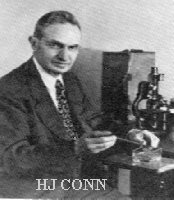The History
A Brief History of the Biological Stain Commission
Biological stains are used to create visual contrast between tissue elements as tissues are essentially colorless, and when prepared for microscopic examination, transparent. Slight differences in structure, dye content and impurities of the dye used for staining can result in failure of expected coloration of the specimen, leading to an inability to properly identify microscopic structures. These problems were first noticed by the earliest users of dyes in histology and remain a concern today.
The first attempt at quality assurance in biological dyes was the result of advice given to a graduate student by pathologist Dr Carl Weigert, in 1880. The graduate student was Georg Grübler, who soon after completing his studies began supplying biological dyes that gave reasonably consistent results. The Grübler label came to be accepted as an adequate quality assurance, and these German dyes achieved virtually a world-wide monopoly.
During World War I there was a blockade of German products, including dyes. As a result a dye industry was initiated in the USA. This early industry had much to learn, and its products were at first not only poor textile dyes, but were often impossible to use as biological stains. After the USA entered the war, and as the armed services expanded, many new laboratories had to be developed, and the dye quality situation became even worse. Particular problems focused on the dyes basic fuchsine and gentian violet, which were important to bacteriologists, and eosin, hematoxylin, methylene blue and phloxin which were used by histologists. While these were the dyes most important for diagnostic studies at the time, almost all dyes used in histological and microbiological staining were causing problems..

Harold J. Conn
By 1920 the supply of prewar dyes was almost exhausted, foreign supplies were erratic, and the domestic dyes still often unsatisfactory. As a consequence, several concerned groups and individuals came together: Harold J. Conn, from the Society of American Bacteriologists; Rolland T Will, of the Will Corporation, a laboratory equipment supplier; C. E. McClung, a member of the National Research Council and an academic zoologist; S. I. Kornhauser, of the American Society of Zoologists and later Head of the Anatomy Department at the University of Louisville; and L. W. Sharp, of the Botanical Society of America. Two key conferences on the standardization of stains were held in 1921, involving these people.
Growing from this activity came the Commission on the Standardization of Biological Stains, whose original executive committee members were Conn, Kornhauser, and Sharp, and also Frank B. Mallory representing the American Society of Pathologists and Bacteriologists, and J. A. Ambler of the American Chemical Society. Dr Ambler was head of an office of the US Department of Agriculture known then as the Color Laboratory, and he offered the facilities of that laboratory for the necessary chemical work. His assistant was H. C. Holmes, who became very active in this work. By 1923 the Commission already had a constitution which is recognizably the forerunner of the Aims of the present Commission.
Initially funding was via the Chemical Foundation. Funding from sale of certification labels to manufacturers, for placing on bottles of those batches tested and found satisfactory, slowly became more significant as a source of Commission finance.
The practical work of the Commission began in 1922 with staining tests made by a group of collaborators under the supervision of Conn at the Agriculture Experimental Station at Geneva NY, while the chemical work was performed at the Color Laboratory under a ‘memorandum of understanding’ with the US Department of Agriculture. By 1929 a chemical assistant was in place there. By 1946, after various adventures and misadventures, her successor was carrying out the assays at the New York Agriculture Experimental Station at Geneva NY, under the direction of E. H. Stotz. When funds became available for a technician, the number of biological staining tests made at Geneva increased, and more rapid progress was made in the certification of additional stains.
In parallel with this, Dr Conn – while Chairman of the Commission – published in 1925 the first edition of Biological Stains. This book has become a standard source of reference in technical and research histopathological and biological laboratories using dyes. The book has been kept up to date by regular revisions, with a 10th edition (2002) being the most recent version.
 Another activity undertaken by Dr Conn, in 1925, was the establishment of a journal to serve as a medium of publication for the Commission. Stain Technology, whose first issue appeared in 1926, is still published, with a name change in 1991 to Biotechnic & Histochemistry. Dr Conn was the original editor for almost 30 years.
Another activity undertaken by Dr Conn, in 1925, was the establishment of a journal to serve as a medium of publication for the Commission. Stain Technology, whose first issue appeared in 1926, is still published, with a name change in 1991 to Biotechnic & Histochemistry. Dr Conn was the original editor for almost 30 years.
The great demands of the armed services for dyes during World War II brought appreciable income to the Commission based on the sale of certification services and labels for stain bottles. The improved financial status made it desirable to incorporate the organization. This was done in 1944, and the name changed slightly, to the Biological Stain Commission.
In 1947 Dr Stotz was made head of the Biochemistry Department of the University of Rochester School of Medicine and Dentistry. He found that the Dean, G. H. Whipple, was very sympathetic towards the Stain Commission and so was able to transfer all the assay work there. Not long after, Miss Darrow – who had been in complete charge of the biological testing of stains since 1937 – was also transferred to Rochester. At present, the Research and Assay Laboratories of the Biological Stain Commission are located at the University of Rochester Medical Center, Rochester NY. Its powers are vested in a board of trustees, 4 of whom are officers. Much of the chemical and biological testing continues to be performed at the labs in Rochester. For testing in certain special procedures, samples are also checked by collaborators in other laboratories.
Acknowledgement: this account, by the late Dr Alton Floyd, a former President of the BSC, is based on an article in American Society for Microbiology News 40: 252-259 (1974) by the late Dr George Clark, who was a Trustee of the Commission.
